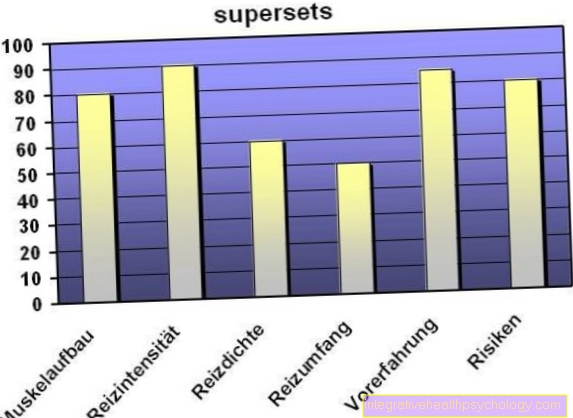Xeroderma pigmentosum

definition
Xeroderma pigmentosum is a hereditary disease caused by defective repair mechanisms in DNA repair during cell division. These defects lead to an increased sensitivity to light (Photosensitivity) of the skin against UV rays, premature skin aging and an extremely increased risk of skin cancer from a young age. In addition, diseases of the nervous system and the eyes can occur.
Epidemiology
Xeroderma pigmentosum is very rare. The frequency is worldwide around 1: 1,000,000, in Europe however at 1: 125,000, in Japan even at 1: 40,000. Most of the patients come from Japan, Germany, North Africa, North America and Turkey. men and women are equally affected.
history
First was described Xeroderma pigmentosum 1870 by Ferdinand von Hebra (1816-1880), Austrian dermatologist from Vienna and Moritz Kaposi (1837-1902), Hungarian dermatologist also from Vienna. They designated XP release in 1870 "Textbook of Skin Diseases" as xeroderma or as parchment skin and defined it as a Tissue shrinkage (atrophy) of the skin. In a publication in 1882, Kaposi pointed out pigment abnormalities as an important symptom and therefore gave this disease the name Xeroderma pigmentosum.
Albert Neisser (1855-1916), German dermatologist, was the first to discover in 1883 that neurological diseases were also involved Xeroderma pigmentosum stay in contact. A few years after Neisser's discovery, Charles Louis Xavier recognized Arnozan (1852-1928), French doctor, the harmful effects of light and air on the course of the disease of Xeroderma pigmentosum.
In 1969, J.E. Cleaver identified the cause of Xeroderma pigmentosum and thus took the first step towards understanding the central role of DNA mutations cancer. This has given the disease a special place in the history of medicine.
Causes of xeroderma pigmentosum
Xeroderma pigmentosum is a hereditary disease that autosomal recessive is inherited, i.e. two defective genes have to come together, i.e. both parents have to carry the defective gene in order for the disease to break out. Sun exposure, UVB radiation more than UVA radiation, changes the DNA that is in cells exposed to the sun. A component of the DNA, the base thymine, doubles particularly often, so that the new DNA strand is functionally inactivated. Usually the cell has repair mechanisms in place to fix the fault. In xeroderma pigmentosum these mechanisms are reduced or defective.
There are seven different types of XP, which are subdivided according to the location of the gene defect (AG), and a variant with different gene defects: In the XP groups, a mechanism is reduced or defective, which removes the second thymine base from the Cut out the DNA strand and replace it with the correct base (Excision mechanism). Therefore the double thymine bases are retained (Thymine dimers) and are then completely cut out by a faulty emergency mechanism, which leads to a mutation of the DNA strand and thus to a mutation of the body. This leads to an accumulation of DNA damage and mutations from UV rays, drugs or free radicals.
Types
The classification of Xeroderma pigmentosum was developed from completion groups. These were Connective tissue cells (Fibroblasts) from different XP patients. If the DNA repair defect persisted after the fibroblast fusion, the patients were of the same XP type. But when the DNA repair defect no longer existed, the patients suffered different types of the disease. This classification was later confirmed by genetic analysis. In some types of XP, the genetic defect can also be diagnosed by direct gene transfer. At the moment this routine genetic analysis is only available for the XPA gene, and development is in progress for the remaining types.
The types (A-G) differ in Age of onset, frequency, Severity of the disease and Type of caused by UV radiation Tumors. Some types (A, B, F, and G) can also be associated with neurological disorders.
- Type A: early age of onset; very high light sensitivity (Photosensitivity); Skin tumor: spinocellular carcinoma; Function of the defective gene: discovery of damaged DNA; common in Japan, associated with DeSanctis-Cacchione syndrome
- Type B: very high photosensitivity; Function of the defective gene: Separation of the DNA double strand into single strands (enzyme = helicase); Transitional syndrome from Xeroderma pigmentosum and Cockayne syndrome
- Type C: high to very high photosensitivity; Skin tumor: spinocellular carcinoma, basal cell carcinoma; Function of the defective gene: discovery of damaged DNA
- Type D: high photosensitivity; Skin tumor: malignant melanoma; Function of the defective gene: helicase; Transitional syndrome from XP and Cockayne syndrome, trichothiodystrophy
- Type E: late age of onset, increased photosensitivity; Skin tumor: basal cell carcinoma; Function of the defective gene: discovery of damaged DNA
- Type F: high photosensitivity; Function of the defective gene: cleavage of the DNA (endonuclease)
- Type G: high photosensitivity; Function of the defective gene: endonuclease, Xeroderma pigmentosum transitional syndrome and Cockayne syndrome
- Variant: late age of onset, increased photosensitivity; Skin tumor: basal cell carcinoma, function of the defective gene: structure of DNA (DNA polymerase), better course than the other types
Symptoms of xeroderma pigmentosum
An increased sensitivity to light is usually noticeable in small children. Even a short stay in the sun can lead to sunburn, which for weeks appears as an inflammatory reddening (Erythema) can exist. After months or a few years, chronic photodamage occurs on areas of skin exposed to the sun: light or dark spots (De- or hyperpigmentation), dry skin with tissue loss (atrophy) and premature aging of the skin (actinic elastosis). After all, possible preliminary stages of skin cancer already occur in childhood and adolescence (Precancerous lesions) and malignant skin tumors such as basaliomas, spinaliomas, and melanomas. Scarring and mutilation of the nose and eyes (Mutilation) observed.
Neurological changes are seen in 20% of all XP patients. This can include reflex disorders, spasticity, impaired movement coordination (Ataxia), Nervous system disease (Neuropathies) and intelligence disorders. Type A patients may experience mental retardation and dwarfism (DeSanctis-Cacchione syndrome). Eye changes are seen in 40% of patients. The anterior segments of the eye and the eyelids are affected. Photophobia (Photophobia), Inflammation of the conjunctiva (Conjunctivitis), Ulcers (Ulceration) and pathological changes in the cornea (Corneal dysplasia).
diagnosis
It is very important that Xeroderma pigmentosum is diagnosed as early as possible. If Children under two years you should already have spots on your sun-drenched skin Xeroderma pigmentosum think that children of this age should normally not have such discoloration. Also Children with noticeably rapid reddening in the sun should consult a dermatologist.
The diagnosis itself happens through Cultivation of cells from connective tissue (Fibroblasts), by Extracting tissue in the skin (biopsy) be won. These are then examined for DNA repair mechanisms, UV sensitivity and faulty DNA synthesis. Different types of the disease can be caused by one direct gene transfer be diagnosed. If the DNA repair mechanism works properly again after a certain gene has been administered, it is the type in which the given gene is defective.
Even the diagnosis of one Embryos in the abdomen (prenatal diagnostics) is possible through genetic analysis.
Differential diagnosis
Xeroderma pigmentosum must be differentiated from other rare syndromes such as Cockayne syndrome, lupus erythematosus and porphyrias. Like XP, Cockayne syndrome is caused by a defect in the DNA repair mechanism, but there are no pigment disorders and skin tumors.
Lupus erythematosus is an autoimmune disease, the cause of which is not fully understood, but viruses or UV light are suspected. There is an excessive reaction of the body's defense system against the body's own cells. The first symptoms are fever, fatigue and sensitivity to sunlight.
Porphyrias are metabolic diseases that are related to the disruption of the structure of the red blood pigment heme. In cutaneous porphyria, a type of porphyria that affects the skin, there are no changes in the skin when the skin is exposed to direct sunlight despite the pain; swelling, redness and even extensive burns only occur after 12-24 hours. Other symptoms include scarring, blistering of the skin, tissue death, and disfigurement such as loss of the nose, lips, auricles. Type D is occasionally with Trichothiodystrophy connected. The characteristic syndrome of this disease is short, brittle hair. About half of the patients have an increased photosensitivity, also caused by defects in the repair mechanisms of DNA damaged by UV light.
Treatment of xeroderma pigmentosum

There is no therapy for the underlying disease; patients can only be protected by avoiding UV radiation. The light-altered skin must be checked every three to six months. Precancerous lesions must be scratched out (curettage), Tumors must be removed surgically.
However, research into gene therapy gives hope. A bacterial protein is to be introduced into the body, which then replaces the defective DNA repair mechanisms and takes over the DNA repair.
prophylaxis
To stand in front of the UV radiation To be able to protect, UV-impermeable helps Protective clothing and sunscreen. In addition, a Glasses or a face mask be worn with UV protection. The best way to avoid sunlight is this Changeover of the day-night rhythmwhat should be done in childhood (moonlight children). It has a significant impact on later life and career choice.
A prophylaxis new Skin tumors can through Taking retinoids such as isoretinoin or aromatic retinoid be tried. Retinoids are with that Vitamin A (Retinol) related. The dose, however, has to be much higher than with conventional therapies, which is why this drug therapy is often not tolerated.
forecast
Health status progressively deteriorates. The risk of malignant skin tumors is 2000 times higher, making the first skin tumor an average at the age of 8 arises. Often the patients die even before the age of three of malignant tumors (Malignancies), the Metastases sprinkle. But there are also patients who have reached the sixth decade of life. Just one consistent UV protection improves the course.
Summary
Xeroderma pigmentosum is a rare, autosomal recessive hereditary disease. Defective DNA repair mechanisms result in unrecovered DNA damage, which leads to cell, tissue and organ damage. Life expectancy is shortened.


.jpg)


























